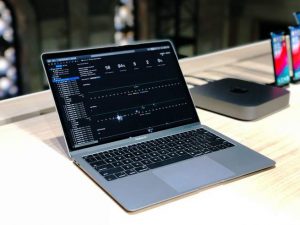By Anca Gagiuc on November 3, 2018 in Technology
Hardware announcements from Apple late last month seem likely to satisfy some longtime w ishes of Mac aficionados.
ishes of Mac aficionados.
The MacBook Air, the company’s “budget” line of laptops and its most loved Mac, has finally been fully redesigned and reengineered, adding hardware features that have become standard on MacBooks and MacBook Pros.
It now sports a crisp 13.3-inch Retina Display (think 4 million pixels) that has 48 percent more color than the previous version, while the chunky aluminum bezels were replaced with some slim black lines that drop the size of the laptop by 17 percent. The Retina display gives the screen more than four times the resolution of the prior Air laptops and is more than visible as soon as you lift the lid. If you’re familiar with the 13-inch MacBook Pro, know they share the same resolution. The only thing missing is the True Tone display, present in the latest generation of Pro laptops.
Connectivity-wise, the device has two Thunderbolt 3 ports (USB-C), unfortunately on the same side, and sadly no more MagSafe. The novelty is Touch ID, now part of the package with a keyboard-based sapphire fingerprint scanner, which can also be used with Apple Pay. There is one more thing the Air has—the 3.5mm jack port.
The keyboard has Apple’s butterfly mechanism and a Force Touch trackpad that is 20 percent larger than the one on its predecessor. The speakers’ power got a 25 percent boost in volume and emits twice the bass. Video calls, dictation and Siri should also show improvement thanks to the three-microphone array.
The new Air now has Siri onboard and, for the first time, it’s made of 35 percent post-consumer recycled plastic (for the speakers) and 100 percent recycled aluminum to help reduce the computer’s carbon footprint by nearly 50 percent, making it the greenest MacBook ever.
Under the hood, the 2.75-pound device (1.25kg and 25 percent lighter than its previous iteration), feeds off a dual core 8th generation Intel i5 with up to 16GB or RAM and up to 1.5TB of SSD storage (for this configuration get ready for an expensive offer). The battery life is touted to hold the user connected throughout the entire day or some good solid 12 hours. Prices start at $1,199, with availability from Nov. 7. Choose your color from the classic Silver, Gold or Space Gray. The very first Air was launched by Steve Jobs out of a manila envelope for visual effect, but know that this iteration is even smaller, lighter, more powerful and still affordable for a MacBook.
An upgraded Mac Mini was also introduced at the Brooklyn Academy of Music. From the looks of it, not much seems different (except for the new space gray color), but once you look into it, you will notice that the overhauled device comes with a quad-core 8th generation Intel processor with an option to upgrade to a six-core version. This new version makes it five-times faster than the older Mac Mini. The memory standard is 8GB of RAM, which can be expanded up to 64GB. In addition, there is support for up to 2TB if SSD storage. Talking about a lot of power in a small package.
The Mini is equipped with more ports than ever before—four Thunderbolt 3 ports, two USB-A ports, an HDMI 2.0 port and an upgradable Ethernet port. Judging just by the array of ports, one can easily call the Mini Apple’s pro tool for people who need something that will plug into a custom hardware setup.
Part of the materials used in building this device are also recycled—aluminum and plastic. The device will sell under two configurations, for $799 and $1,099, also available starting Nov.7.
The iPad flaunts a new Pro version, which is basically competing against less powerful laptops rather than other tablets. The version takes after the iPhone and ditches the Home button in favor of Face ID. Somehow, they’ve managed to keep the 7-megapixel front-facing camera at its usual spot, despite having lost the bezel in favor of a slim border. Just like the iPhone, it uses the same Liquid Retina display with two options for screen size: 11 and 12.9 inches, with 5.9mm in thickness (0.2 inches). To compensate for the button’s navigational properties, the device features a series of contextual swipe shortcuts to switch apps and setting up split-screen with two apps, among other things.
The new tablet has significantly more power than the last model, thanks to the new A12X Bionic chip, a 7-core GPU and an 8-core CPU. This chip has the Neural Engine, which runs five trillion operations per second and enables advanced machine learning. Apple claims the new iPad Pro can perform some tasks 90 percent faster and it’s faster than 92 percent of portable PCs. All this power enables its 12-megapixel rear camera to shoot in 4K at 60 frames per second.
With the release of the powerful iPad Pro, the new Apple Pencil was introduced. The tablet has 102 magnets on the inside, which means the Pencil can snap to any of its sides. When these touch, the iPad syncs to the pencil and it charges it wirelessly.
The lightning port was replaced with an USB-C port, which makes it much easier to connect to a wide range of peripherals. The port can “reverse charge”, meaning that it can charge your iPhone if you connect it. The maximum storage you can get in the new iPad Pro is 1TB, but it will cost you a good $1,749.
The 11-inch iPad Pro will start at $799 for the 64GB model. The 12.9-inch model will start from $999 for 64GB.
Adobe + Apple = finally!
All this power in the new iPad Pro can be put to good use with the upcoming version of the essential image editing program for iOS that removes some of the key limiting factors in previous iOS Photoshop apps. Designers rejoice!


